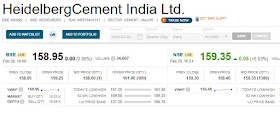By Morningstar | 29-03-18 |
Director of fund research Kaustubh Belapurkar, speaks to ET NOW, on what fund managers are buying.
Large-cap stocks seem be in favour. What is exactly happening in that space?
There has been a fair bit of activity in the large-cap space because money has been coming in from retail investors. A number of large-cap names that are coming up are unusual; such as Tata Steel, Power Grid, Bharat Petroleum, TCS and NTPC.
Idea Cellular came up purely because there was a Qualified Institutional Placement, or QIP, and lot of managers subscribed to it.
SBI continues to see buying despite the pressure on the prices post the Punjab National Bank scam.
The difference is that last year we saw mostly banks being bought but this year the flavour has changed. We are seeing a number of basic material companies, auto and technology stocks also being bought by managers.
Are you seeing large ticket exits for some of the large private corporate banks like ICICI Bank or Axis Bank because there has been a fair amount of price correction there too?
The interesting thing is that there may have been some buying of public sector banks after the price correction.
SBI and BoB have been added a fair bit and even PNB has seen some minor additions. I think the fund managers need to see a substantial price correction to get into some of these counters. The likes of HDFC Bank and ICICI Bank, continue to see addition. Axis Bank is another name which saw a fair bit of addition.
There has been some profit booking on private banks like Kotak Mahindra, IndusInd and Yes Bank. Financials is not something that has been sold extensively.
Having said that, the enthusiasm with which the managers were buying in 2017 has definitely come off because they are already loaded up in positions and they want to look at other counters and sectors which are better buys at this point of time.
A correction played out in Metals globally and it rubbed off on us too after Trump announcing those tariff hikes. There is enough proof that the commodity is in an upcycle but are you seeing any capital protection within Metals?
Interestingly, we are betting on domestic demand picking up in Metals. You can see additions in Tata Steel, Jindal Steel and Power, Hindalco and SAIL. Metals saw a fair bit of buying in the month of February too.
What is your sense when it comes to the connection between crude oil prices and some of the large-cap upstream and downstream oil and gas companies?
In the oil and gas segment, the interest has been limited over the last few quarters. We have not seen any large additions like the ones we saw last year.
Companies like BPCL and HPCL continue to see minor adding though nothing exceptional. IOC is one counter where we have actually seen selling in the previous month. I think it is a mixed bag. There is obviously a wait-and-watch situation to see around what level oil prices stabilise or if they continue to go up. I think managers will take some time before they take a call to get back more aggressively into these counters.
What is the kind of churn that you are seeing happening when it comes to large caps as a whole?
Since large caps saw a fantastic run up in January, where clearly a lot of these stocks moved up, managers did not mind taking some profit off the table. Despite the correction in February, a healthy amount of money was made over the last year or two. The focus is now slowly shifting. You can see a lot of buying happening in power utilities, commodities, basic materials and cement. Banks are no longer the darling of the Street from a fund managers' perspective. That trend has definitely changed.
What is the outlook on IT, based on the management commentary as well as the way the currency is shaping up?
IT remains a very staggered play. I do not think too many of the midcap names really have got into much buying. The one name that pops up was Cyient that has seen some buying. But beyond that buying was prevelant in the large-cap IT space and Infosys particularly was that one counter that saw a lot of activity.
TCS has been playing a little bit of catch up now but Wipro still remains a flattish bet for manager.
So I think it is going to be a very stock specific play right now. It is not going to be broad-based buying from managers as yet.
What should be one's strategy when it comes to mid caps in the current market scenario?
Fund managers have been rightfully watchful of the midcap space not just now but over the past year when valuations clearly ran up and there was lot of exuberance shown. So managers have been extremely selective in this space.
While large caps remain the largest pie of what managers are buying, select midcaps do see buying. Investors are seeing value in Triveni Turbines and Voltas. Managers will continue to cherry-pick midcaps as it is not going to be an all-in sort of trade. They will be very careful about where they allocate money on the mid-cap side.
Next Read :Equity markets are down.it is Time for action
Prevoius Read : IndusInd Bank - Q4FY18 Results Update - Operating Performance Remains Healthy
Next Read :Equity markets are down.it is Time for action
Prevoius Read : IndusInd Bank - Q4FY18 Results Update - Operating Performance Remains Healthy







